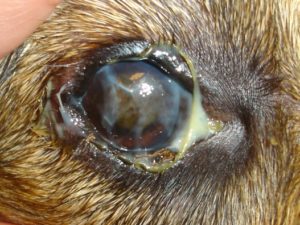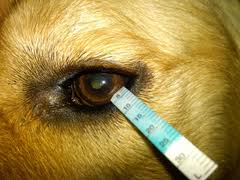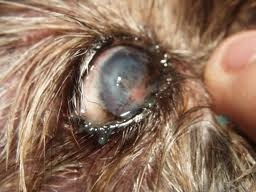Remember the last time you got something in your eye? The intense irritation. The desire to rub it all the while knowing that’s the worst thing you can do. Tears streaming out from tightly closed lids, flushing out the irritant from the eye.
Eyes are very sensitive structures because they are so important.. They have a much higher loading of pain fibres just to make sure that we look after them. Eyes are protected by the eyelids and the blink reflex that means your lids snap shut automatically if your eyes see something coming close. They are also protected by the tear film which keep the specialised skin cells of the cornea from drying out, as well as flushing out irritants and germs.
There is a particular disease affecting tear production that is common in dogs. The medical name is keratoconjunctivitis sicca (KCS) but it is most often called ‘dry eye’. It happens when tear production is reduced.
In dogs and cats most tears are produced by a gland in the upper eyelid. A gland behind the third eyelid also produces some tears. We think of tears as salt water but they also contain mucoproteins that add lubrication, proteins that fight germs, and oils that coat the surface of the tear film, slowing evaporation.
Signs of ‘dry eye’
The initial signs of dry eye are subtle and are easily ignored by the owner. Low grade conjunctivitis doesn’t seem to bother the dogs as much as it bothers us. Some extra mucus builds up in the corners of the eyes. Initially this looks like grey sludge, but will become yellow or green with bacterial infections. As the inflammation of the cornea worsens affected dogs will blink more, keep their eyes partly closed, or rub at their eyes. By looking closely you can see the cornea looks dull and dry, instead of moist and shiny. In severe cases the cornea seems covered with sticky mucus that is hard to bathe off with a wet tissue. The cornea underneath may have become discoloured with black pigment causing vision loss. Ulcers of the cornea happen due to the damaged superficial layers and infection.

A severe case with discoloured cornea limiting this dogs vision
What is the cause?
Easily the most important cause of dry eye is immune mediated disease. This is when the body’s immune system attacks some of its own tissues. Immune mediated disease is more common in females than males, and this is true for dry eye too. Certain breeds have a much higher incidence: West Highland, Yorkshire and Jack Russell terriers, Cavalier King Charles, Cocker and Springer spaniels; Miniature Schnauzers, Lhasa Apsos and Shih Tzus; and in the larger dogs Labradors, Collies and Bulldogs.
Rarely the immune mediated disease is triggered by a course of sulpha antibacterial drugs.
Trauma to a tear gland or to the nerve controlling a tear gland can be the cause but then only the eye on the affected side is affected. Middle ear infection can affect the nerve.
Hypothyroidism, another immune-mediated disease, may increase the risk for dry eye.
Diagnosis is simple!
Tear flow can be easily measured using blotting paper that has been specially calibrated so that normal dogs will wet the paper for a distance of

Using the Schirmer tear test to measure tear flow
15mm in 60 seconds. It is called the Schirmer Tear Test (STT). It is relatively simple and quick to perform. Any dog in which dry eye is suspected should have this test.
More importantly dogs of the at-risk breeds should have this test at their annual health check to screen for early KCS.
Early diagnosis and treatment are important in this disease because the longer the disease is present, the more tear gland tissue is destroyed, meaning that subsequent treatment is less effective.
Obviously other causes such as middle ear disease and hypothyroidism need to be checked for and ruled out too.
Treatment is simple too!
Twenty-five years ago the miracle drug cyclosporin revolutionised the treatment of dry eye. This is a potent immunosuppressive drug, the same one used to block rejection in organ transplant recipients. Used as eye drops it is highly effective in restoring tear production in those patients which have not had too much tear gland tissue destroyed. Even corneas which have become opaque with black pigment deposits can become clear, restoring vision. But it is expensive.

Typical thick sludge and some corneal discoloration affects this dog’s vision
Artificial tears and eye lubricants can be used but they need to be applied frequently, and because they don’t block the immune-mediated destruction of the tear glands the disease progressively gets worse.
Some patients need antibiotic drops to control infections while tear production returns.
In patients with long-standing disease the tear glands may be destroyed. In these dogs cyclosporin won’t work. Rarely can eye lubricants provide enough protection. A surgical procedure called parotid duct transplantation allows the eyes to be continually moistened with saliva. This is very effective. Of course when these dogs see food their eyes water, and excess saliva will often run down their face, but that is a small price to pay for comfort and vision.

Recent Comments